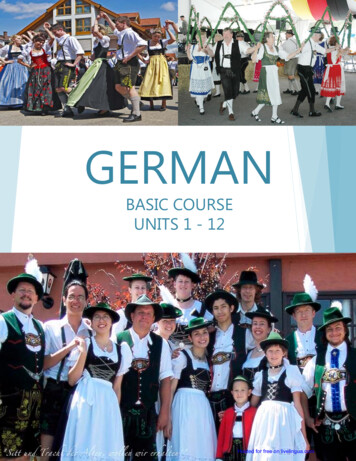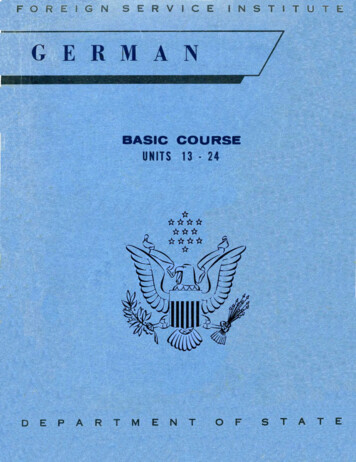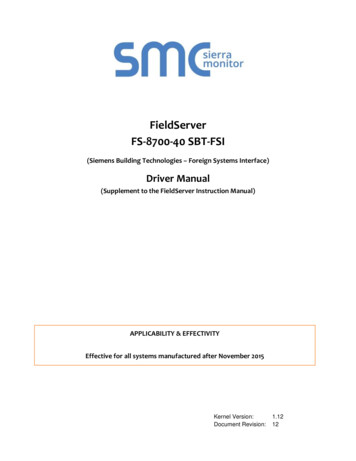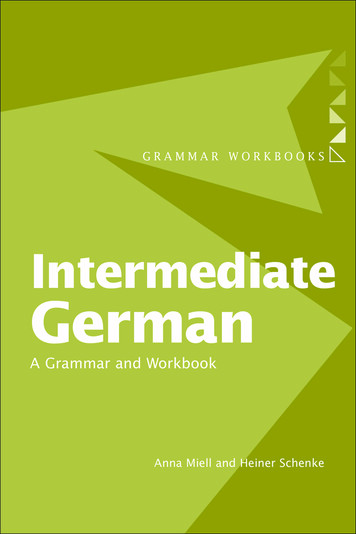
Transcription
GERMANBASIC COURSEUNITS 1 - 12Hosted for free on livelingua.com
BASIC COURSEGERMANPRBFACEPrefaceThis Basic Course in German has been des·igned to assist UnitedStates Government representatives who require a command of spoken German.The general concept of this text has grown out of the plan of SpokenLanguage courses prepared under the auspices of the American Council ofLearned Societies during World War II. But pattern drills and otherexercises have been developed extensively at the Foreign Service Institute to provide a much fuller manipulation of forms and patterns. anda conscious attempt has been-made to adapt situations and vocabulary tospecific needs of the Foreign Service. And the course is intended tolay asolid foundation for comprehensive language skills. providingsystematically for the development of reading proficiency based on oralaural skills.This text is the end-product of several years of work and has benefited from the labors of many members and former members of the FSI staff.In its present form it was prepared under the supervision of Dr. Samuel A.Brown. who has had overall responsibility for the arrangement of situational material and for the organization and presentation of structural features. Particular credit for the dialogs and much of the drill materialgoes to Mrs. Ilse Christoph. Mrs. Christoph has been assisted by Mrs.Maria-Luise Bissonnette. Mr Friedrich Lehmann. Mr. Gerhard Matzel.Mrs. Margarete Plischke and Mrs. Erika Ouaid. A most valuable contribution was also made by Mrs. Quaid in preparing the major part of thetypescript. assisted by Miss Gene. i ve Ducastel. The project has beena cooperative venture. however. and all members of the German staffhave contributed freely the fruit of their classroom experience and thegifts of their imagination and insight.A rDean. School of Lan uagesForeign Service InstituteiiiHosted for free by Live Lingua GermanHosted for free on livelingua.com
I NTRODUCTl ONGERMANBASIC COURSI:lntroductionAlMlt is the aim of the course to provide the student with a usefulcontrol of the structure of the spoken language and of a basic vocabulary which meets at least some of the specialized needs of the ForeignService. After completion of the basic course the Foreign ServiceOfficer should be able to make limited practical use of the languagein his official duties and social obligations. He will furthermorehave the means, given the proper surroundings and personal motivation,for continued rapid and efficient development of proficiency.MATERIALSThe materials in this first volume of the text are organized intotwelve lessons or units. Each unit contains a set of basic sentencesfor memorization. These are in the form of a dialog based on one orsometimes two specific situations in which a person might find hirnselfin Germany. Notes to the basic sentences are provided as necessary toclarify occasional difficulties in vocabulary and idiom and to provideadditional background on some cultural features unfamiliar to Americans. Notes on pronunciation are included in each of the first eightunits. Phonological features which have been found to be particularlydifficult for American students are here presented with explanationsand pronunciation practice drills. The notes on qrammar in each unitsingle out those structural features illustrated in the basic sentenceswhich are appropriate for systematic consideration at that stage in thecourse. Substitution drills provide for the manipulation of forms bysubstituting specific items in fixed sentence frames. They are intended to build habits of association, so that in a given syntacticenvironment the appropriate grammatical form automatically comes tomind. As the German vocabulary is all familiar, no English equivalents are given in these drills. Variation drills provide for themanipulation of larger syntactic patterns. In each group a model sentence, underscored, serves as a guide. Associated with it are additional sentences incorporating the same syntactic pattern but inwhich most of the individual word items have been replaced. Englishequivalents are given to serve as cues for recall of the German variantsentences.Vocabulary drills provide both practice in the use of newvocabulary items and also allow for manipulation of sentence elementswhose particular form and arrangement depends upon their associationwith that vocabulary item. The manipulation of both variation and vocabulary drills depends on the use of English equivalents. Specifictranslation drills are also provided, however. In most cases theypresent the material of the basic dialog in the form of a narrative.They thus provide content review of the basic sentences and practice inthe transformation from active dialog to descriptive narration. Theresponse drills are question and answer drills on the situations of thebasic dialogs. Conversation practice and additional situations in outline bridge the gap to free conversation with small pieces of supplementary dialog for acting out and situations providing for a freer playof the student's imagination. The finder list in each unit notes allnew vocabulary which has been presented.METHOD AND PROCEDUREThis is a course in Spoken German the forms and patterns of thelanguage are intentionally colloquial. The emphasis in instruction isivHosted for free by Live Lingua GermanHosted for free on livelingua.com
BASIC COURSEGERMANIlftItODUCTIONev rywhere on speech, and an indispensable component of the learningprocess is the voice of a tutor, or instructor, whose native languageis German. On no account should the student attempt to use thesematerials without either a native instructor or recordings of a nativeinstructor's voice. The method of instruction incorporates quidedimitation, repetition, memorization, pattern practice, and conversation.Working under the supervision of a linguist the tutor's role is toserve as a model for speech and to guide the student to accurate imitation by constant repetition and c rrection. The student's job is towatch and listen to the tutor carefully and to imitate as exactly as hecan the sounds which he hears. He must be prepared for constant correction and repetition. Each time however the instructor will give hirna model to follow by repeating the item first. The student shouldnever attempt to read from his text but should always wait until hehears the word or utterance as the tutor speaks it for hirn. As far aspossible he should leave his book closed during the presentation ofnew dialog material and keep his eyes on the tutor. Students will beasked to repeat in chorus and individually and will be expected to repeat many, many times, even when their imitation has been good andaccurate. Only by constant repetition after an authentie model forspeech can habitual fluent and accurate reproduction of the sounds andforms of the foreign language be achieved.The basic sentences are preceded by "build-ups" giving the component parts of the utterance separately. Each new item which isintroduced appears first as a build-up. The tutor will ask thestudents to repeat the build-ups separately first, then combined intolarger units and finally the complete new sentence or utterance. Thebasic sentences are sub-divided into numbered sections, each to betreated as a unit, repeated in chorus and individually, with and without build-ups, until the students' imitation is satisfactory. Then anew section may be begun. The time required to cover each section inthis way will differ widely depending on the size and ability of theclass. After acceptable imitation and accurate pronunciation has beenachieved in one or more sections they are assigned for memorizationoutside of class or repeated in class until memorized. The studentshould be able to give either the German sentence or its English equivalent on request or switch from one to the other and back aqain. Thetutor will drill by repeating each sentence for each student in theclass, then by giving each student a different sentence, repeating it forhirn first, and finally asking the students to recite the sentences inorder, the first student the first sentence, the second student thesecond sentence, etc., without receiving a cue from the instructor.Repetition outside of class, preferably using recorded materials as aguide, should be continued to the point of overlearning. The studentshould not only be able to give the correct German sentence immediatelyupon hearing an English equivalent, at random selection, he should alsobe able to give the correct German sentence with equal ease and speedof response upon hearing its German cue. As a final step the studentsare expected to act out the basic dialog in entirety from memory, withthe tutor or with other students. Only when the basic sentences havebeen mastered to this extent can they be considered to provide anadequate basis for control of the spoken language. It should be notedat this point that the English text accompanying the basic sentencesis not primarily a translation but rather a set of conversationalequivalents. Many apparent discrepancies will be found if the student,vHosted for free by Live Lingua GermanHosted for free on livelingua.com
IlfI'BODYCTIONQERMANBASIC COURSEor the tutor, looks for word-for-word eorrespondenee between theBnglish and German text. It does not exist. Rather, in such and sucha situation this is what is said in German and is what is said inBngl1sh.The pronuneiatlcn praetiee drill. are to be taken up after thepresentation of the basic sentences has been eompleted and memorizationhas been started. Items are arranged in graups aeeording to the partieular phonologieal feature eoncernecl. Words in vertieal eolumnspresent the same phonologieal feature in different environments.Beveral eolumns in a praetiee group eontain related phonologiealfeatures or related phonologieal environments in whieh the same featurereeurs. Words are to be repeated first in chorus and then individuallyby eaeh student after the tutor, at first following the vertiealeolumns and later, for variation and comparison, horizontallyaerossthe page. particular attention should be paid to items in contrast.These are minimum meaningfully distinetive sound patterns, accurateeontrol of whieh is important for eommunieation and eomprehension.Contrasting ward pairs are linked by a dash, and after separate practieefor aecuraey the items should be repeated by pairs to bring out theexaet distinetions between them.The notes on grammar are earmarked for home study. After eaehunit has been started and the first hour or more has been spent inelass on repetition of the basic sentences the student should readthrough the grammar notes to aequaint himself with the grammatiealpoints presented in that unit. During the whole time a particular unitis being worked on in elass the student should eontinue to thegrammar seetion. Many questions whieh he may feel tempted to raise inelass will be found to be answered in the notes on grammar Tbe tutoris speeifieally reguested not to diseuss the language with his students,and the students are asked not to ply him with questions. Time inelass is to be spent using andmanipulating the language and not intalking about it. In eaeh unit one or more grammatieal features arepresented, and the basic sentences have been designed, as far as ispossible eonsistent with natural expression, to ineorporate and illustrate those features. Eaeh point of grammar diseussed is illustratedby sentences whieh are natural utteranees in the language. Tbey aretaken in nearly every ease from the basic sentences of the eurrent orpreeeding units. Tbus the examples are already familiar to the student,and the patterns they eentain, which will be drilled and praeticed inthe seetions to follow, are patterns whieh the student has alreadybegun to assimilate by memorizing the sentences of the dialog.After the basic sentences of a unit have all been repeated severaltimes and memorization has been well begun, werk ean be started on thedrills. Tbe material is designed to provide a maximum of additionalexperienee in using the forms and patterns of the language learned inthe basic sentences. It is assumed, however, that the learner isautomatically able to transfer the experienee gained in the basicsentences to error-free manipulation of these forms and patterns. Tbedrills are by no means a test of what the student ean do with theelements given him. It is a matter of no great importanee whether heean or eannot "figure them out" by himself. Tbe goal is to learn tospeak the language aeeurately and fluentlY, and this aim ean only beaehieved by eorrect repetition of the forms and patterns involved.Tberefore all the sentences in eaeh drill qroup are first to berepeated after the tutor in their correet form. Tbe tutor then cuesviHosted for free by Live Lingua GermanHosted for free on livelingua.com
BASIC COURSEOERMANINTR.ODUCTIONeaeh student in turn for repetition of one of the drill sentences untilall students have given all sentences eorreetly.In the substitution drills the model sentenee and all its variantsare first rep"ated in chorus after the tutor. He then gives the modelsentenee aqain, the elass repeats it in chorus, after whieh eaeh studentis cued individually with an item to be sUbstituted and repeats thesentenee with the substitution ealled fore In some eases the cue isthe exaet form whieh fits into the sentence. In sOftIe eases a cue isgiven whieh requires the student to ehoose the proper form to fit thesyntaetie environment of the model. Regardless of whieh type of cueis given or how simple or eomplex the exereise may appear to be, thestudent's task is to make the substitution without hesitation and torepeat the sentenee aeeurately at normal eonversational speed. Althoughno Bnglish equivalents are given in the substitution drills and thefirst task is rapid, fluent and accurate manipulation of the materialin German, the tutor may ask for spot transl
Bnglish and German text. It does not exist. Rather, in such and such a situation this is what is said in German and is what is said in Bngl1sh. The pronuneiatlcn praetiee drill. are to be taken up after the presentation of the basic sentences has been eompleted and memorization has been started. Items are arranged in graups aeeording to the par











